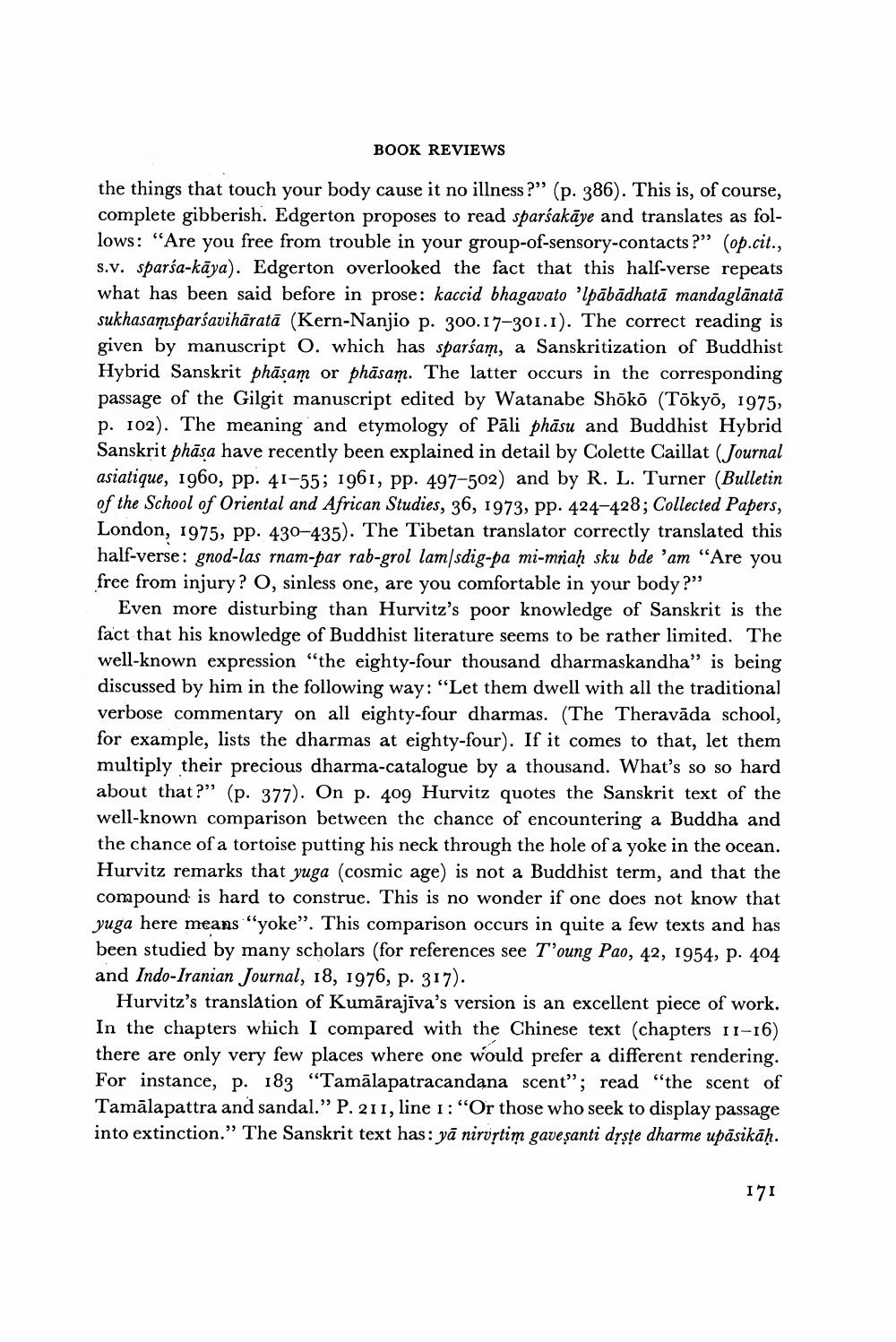Book Title: Book Reviews Of Scripture Of Lotus Blossom Of Fine Dharma Author(s): J W De Jong Publisher: J W De Jong View full book textPage 3
________________ BOOK REVIEWS the things that touch your body cause it no illness?” (p. 386). This is, of course, complete gibberish. Edgerton proposes to read sparśakāye and translates as follows: "Are you free from trouble in your group-of-sensory-contacts?" (op.cit., s.v. sparsa-kāya). Edgerton overlooked the fact that this half-verse repeats what has been said before in prose: kaccid bhagavato 'lpābādhatā mandaglānatā sukhasamsparśavihāratā (Kern-Nanjio p. 300.17-301.1). The correct reading is given by manuscript O. which has sparsam, a Sanskritization of Buddhist Hybrid Sanskrit phāsam or phāsam. The latter occurs in the corresponding passage of the Gilgit manuscript edited by Watanabe Shoko (Tōkyō, 1975, p. 102). The meaning and etymology of Pāli phāsu and Buddhist Hybrid Sanskrit phāsa have recently been explained in detail by Colette Caillat (Journal asiatique, 1960, pp. 41-55; 1961, pp. 497-502) and by R. L. Turner (Bulletin of the School of Oriental and African Studies, 36, 1973, pp. 424-428; Collected Papers, London, 1975, pp. 430–435). The Tibetan translator correctly translated this half-verse: gnod-las rnam-par rab-grol lam sdig-pa mi-mraḥ sku bde 'am "Are you free from injury? O, sinless one, are you comfortable in your body?” Even more disturbing than Hurvitz's poor knowledge of Sanskrit is the fact that his knowledge of Buddhist literature seems to be rather limited. The well-known expression “the eighty-four thousand dharmaskandha" is being discussed by him in the following way: "Let them dwell with all the traditional verbose commentary on all eighty-four dharmas. (The Theravāda school, for example, lists the dharmas at eighty-four). If it comes to that, let them multiply their precious dharma-catalogue by a thousand. What's so so hard about that?” (p. 377). On p. 409 Hurvitz quotes the Sanskrit text of the well-known comparison between the chance of encountering a Buddha and the chance of a tortoise putting his neck through the hole of a yoke in the ocean. Hurvitz remarks that yuga (cosmic age) is not a Buddhist term, and that the compound is hard to construe. This is no wonder if one does not know that yuga here means "yoke". This comparison occurs in quite a few texts and has been studied by many scholars (for references see Toung Pao, 42, 1954, p. 404 and Indo-Iranian Journal, 18, 1976, p. 317). Hurvitz's translation of Kumārajīva's version is an excellent piece of work. In the chapters which I compared with the Chinese text chapters 11-16) there are only very few places where one would prefer a different rendering. For instance, p. 183 “Tamālapatracandana scent"; read “the scent of Tamālapattra and sandal.” P. 211, line 1: "Or those who seek to display passage into extinction.” The Sanskrit text has: yā nirvítim gaveșanti drste dharme upāsikāḥ. 171Page Navigation
1 2 3 4 5 6
